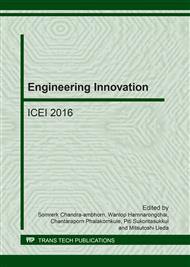p.66
p.72
p.78
p.85
p.91
p.96
p.105
p.111
p.117
Microstructure Characterization of Pure Tungsten Electrodes Used in Gas Tungsten Arc Welding of Aluminum Alloy
Abstract:
Autogenous gas tungsten arc welding (GTAW) using different non-consumable pure tungsten electrodes (EWP) from eight different manufacturers was performed on aluminum alloy 5083 samples. Due to the limited literatures of how tungsten microstructure may affect the weld quality, this paper attempts to investigate the change in microstructure of tungsten electrode after welding compared to the original microstructure in as-received condition. The scanning electron micrograph results reveal different grain shapes and sizes and also different grain growth rate during welding. It was found that the ability to control the grain growth or limit grain size within the balled end of pure tungsten electrode during aluminum welding plays a very important role in determining the quality of the electrode and how long the electrode would last.
Info:
Periodical:
Pages:
91-95
Citation:
Online since:
January 2017
Authors:
Price:
Сopyright:
© 2017 Trans Tech Publications Ltd. All Rights Reserved
Share:
Citation:


